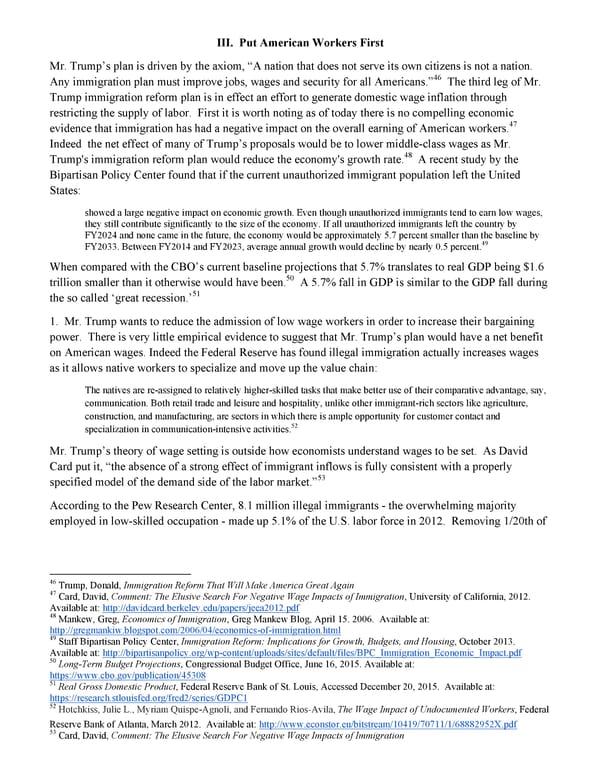III. Put American Workers First Mr. Trump’s plan is driven by the axiom, “A nation that does not serve its own citizens is not a nation. 46 Any immigration plan must improve jobs, wages and security for all Americans.” The third leg of Mr. Trump immigration reform plan is in effect an effort to generate domestic wage inflation through restricting the supply of labor. First it is worth noting as of today there is no compelling economic 47 evidence that immigration has had a negative impact on the overall earning of American workers. Indeed the net effect of many of Trump’s proposals would be to lower middle-class wages as Mr. 48 Trump's immigration reform plan would reduce the economy's growth rate. A recent study by the Bipartisan Policy Center found that if the current unauthorized immigrant population left the United States: showed a large negative impact on economic growth. Even though unauthorized immigrants tend to earn low wages, they still contribute significantly to the size of the economy. If all unauthorized immigrants left the country by FY2024 and none came in the future, the economy would be approximately 5.7 percent smaller than the baseline by 49 FY2033. Between FY2014 and FY2023, average annual growth would decline by nearly 0.5 percent. When compared with the CBO’s current baseline projections that 5.7% translates to real GDP being $1.6 50 trillion smaller than it otherwise would have been. A 5.7% fall in GDP is similar to the GDP fall during 51 the so called ‘great recession.’ 1. Mr. Trump wants to reduce the admission of low wage workers in order to increase their bargaining power. There is very little empirical evidence to suggest that Mr. Trump’s plan would have a net benefit on American wages. Indeed the Federal Reserve has found illegal immigration actually increases wages as it allows native workers to specialize and move up the value chain: The natives are re-assigned to relatively higher-skilled tasks that make better use of their comparative advantage, say, communication. Both retail trade and leisure and hospitality, unlike other immigrant-rich sectors like agriculture, construction, and manufacturing, are sectors in which there is ample opportunity for customer contact and 52 specialization in communication-intensive activities. Mr. Trump’s theory of wage setting is outside how economists understand wages to be set. As David Card put it, “the absence of a strong effect of immigrant inflows is fully consistent with a properly 53 specified model of the demand side of the labor market.” According to the Pew Research Center, 8.1 million illegal immigrants - the overwhelming majority employed in low-skilled occupation - made up 5.1% of the U.S. labor force in 2012. Removing 1/20th of 46 Trump, Donald, Immigration Reform That Will Make America Great Again 47 Card, David, Comment: The Elusive Search For Negative Wage Impacts of Immigration, University of California, 2012. Available at: http://davidcard.berkeley.edu/papers/jeea2012.pdf 48 Mankew, Greg, Economics of Immigration, Greg Mankew Blog, April 15. 2006. Available at: http://gregmankiw.blogspot.com/2006/04/economics-of-immigration.html 49 Staff Bipartisan Policy Center, Immigration Reform: Implications for Growth, Budgets, and Housing, October 2013. Available at: http://bipartisanpolicy.org/wp-content/uploads/sites/default/files/BPC_Immigration_Economic_Impact.pdf 50 Long-Term Budget Projections, Congressional Budget Office, June 16, 2015. Available at: https://www.cbo.gov/publication/45308 51 Real Gross Domestic Product, Federal Reserve Bank of St. Louis, Accessed December 20, 2015. Available at: https://research.stlouisfed.org/fred2/series/GDPC1 52 Hotchkiss, Julie L., Myriam Quispe-Agnoli, and Fernando Rios‐Avila, The Wage Impact of Undocumented Workers, Federal Reserve Bank of Atlanta, March 2012. Available at: http://www.econstor.eu/bitstream/10419/70711/1/68882952X.pdf 53 Card, David, Comment: The Elusive Search For Negative Wage Impacts of Immigration
 THE $900 BILLION QUESTION: ILLEGAL IMMIGRATION Page 12 Page 14
THE $900 BILLION QUESTION: ILLEGAL IMMIGRATION Page 12 Page 14